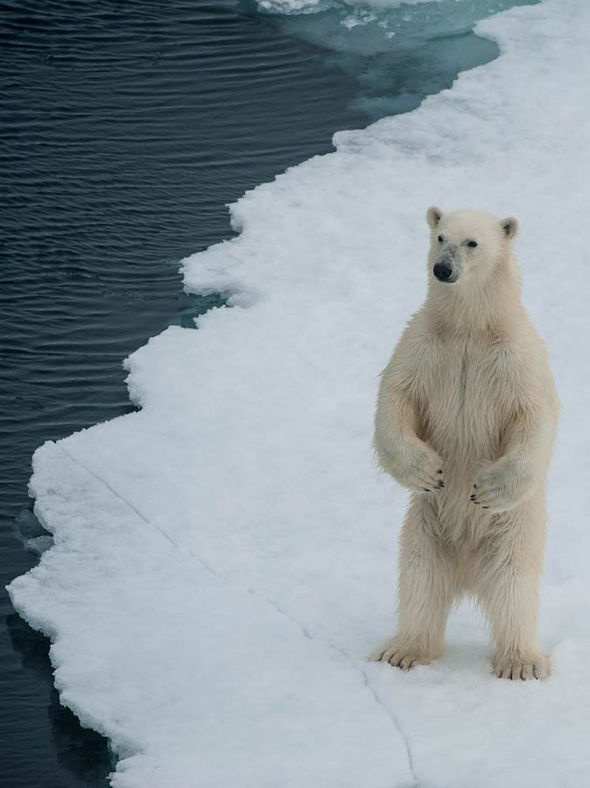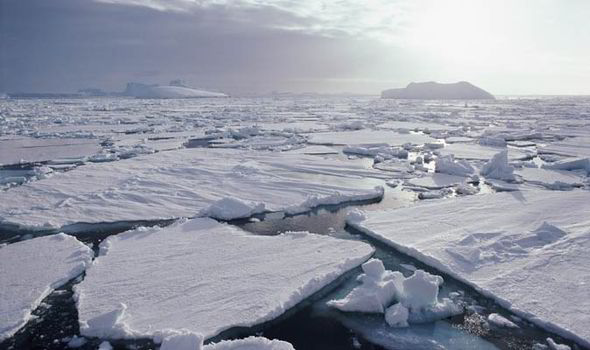EXCLUSIVE: Ice in the Arctic and Antarctic is 'not melting', says global warming expert
fact, the poles are "much more stable" than climate scientists once predicted and could even be much thicker than previously thought.
For years, scientists have suggested that both poles are melting at an alarming rate because of warming temperatures - dangerously raising the Earth's sea levels while threatening the homes of Arctic and Antarctic animals.
But the uncertainty surrounding climate change and the polar ice caps reached a new level this month when research suggested the ice in the Antarctic is actually growing.
And there could even be evidence to suggest the polar bear population is not under threat.
Ted Maksym, an oceanographer at the Woods Hole Oceanographic Institution in Massachusetts, conducted a study in which he sent an underwater robot into the depths of the Antarctic sea to measure the ice.
His results contradicted previous assumptions made by scientists and showed that the ice is actually much thicker than has been predicted over the last 20 years.
Dr Benny Peiser, from the Global Warming Policy Forum (GWPF), said this latest research adds further proof to the unpredictability of the supposed effects of global warming.
He said: "The Antarctic is actually growing and all the evidence in the last few months suggests many assumptions about the poles was wrong.
"Global sea ice is at a record high, another key indicator that something is working in the opposite direction of what was predicted."
He added: "Most people think the poles are melting... they're not. This is a huge inconvenience that reality is now catching up with climate alarmists, who were predicting that the poles would be melting fairly soon."
Separate satellite data released this month showed evidence that at the other end of the globe, the ice in the Arctic sea is also holding up against climate change better than expected.
The data from the European Space Agency CryoSat-2 satellite suggests that Arctic sea ice volumes in the autumn of 2014 were above the average set over the last five years, and sharply up on the lows recorded in 2011 and 2012.
According to this research, Arctic sea ice volumes in October and November this year averaged at 10,200 cubic kilometres.
This figure is only slightly down on the 2013 average of 10,900 cubic kilometres, yet massively up on the 2011 low of 4,275 cubic kilometres and the 6,000 cubic kilometres recorded in 2012.
Dr Peiser, who believes the threat of global warming has been overstated by climate scientists, described this occurrence as "some kind of rebound" adding that no-one knows what will continue to happen to the poles.
He added: "This depends on whether or not we have further warming to come... and this is not certain.
"We do not know what the climate will be in 10, 20 years."
 GETTY
The polar bears are 'actually doing very well'
GETTY
The polar bears are 'actually doing very well'
As well as melting ice, scientists have also been concerned about the population of the polar bears is rapidly decreasing.
But a previous report this summer by Dr Susan Crockford, an evolution biologist at the University of Victoria in Canada, suggested that the polars bears are actually a "conservation success story".
She told the GWPF that the current polar bear population is "well above" the official estimate of 20,000 to 25,000, and could be as high as 27,000 to 32,000.
Dr Peiser said: "People said the poles are melting, so therefore the polar bears will become extinct. They are actually doing very well."
 GETTY
However, other scientists have remained adamant that the poles are melting
GETTY
However, other scientists have remained adamant that the poles are melting However other experts have questioned the accuracy of the latest reports and say it is too early to declare there is no problem with the poles.
Professor Peter Wadhams, a Professor of Ocean Physics at Cambridge University, suggested the research from the Antarctic is based on thick ice which had previously not been sampled by scientists.
He confessed that while the Antarctic sea ice area is increasing, experts do not know how thick the ice really is because they lack the means to measure it.
The reason for this is that "satellites don't work for Antarctic ice thickness because the ice is too wet, while submarines are forbidden to go there", he explained.
He also added that these recent figures on the Arctic "mean little" on their own, and that the trends should be looked at from a wider range.
He explained: "I would say the consensus view of climate scientists is that the trend of area and thickness in Arctic sea ice is very strongly downwards, despite this year's partial recovery.
"It is best to look at five-year running means since annual fluctuations mean little."
For years, scientists have suggested that both poles are melting at an alarming rate because of warming temperatures - dangerously raising the Earth's sea levels while threatening the homes of Arctic and Antarctic animals.
But the uncertainty surrounding climate change and the polar ice caps reached a new level this month when research suggested the ice in the Antarctic is actually growing.
And there could even be evidence to suggest the polar bear population is not under threat.
Ted Maksym, an oceanographer at the Woods Hole Oceanographic Institution in Massachusetts, conducted a study in which he sent an underwater robot into the depths of the Antarctic sea to measure the ice.
His results contradicted previous assumptions made by scientists and showed that the ice is actually much thicker than has been predicted over the last 20 years.
Dr Benny Peiser, from the Global Warming Policy Forum (GWPF), said this latest research adds further proof to the unpredictability of the supposed effects of global warming.
He said: "The Antarctic is actually growing and all the evidence in the last few months suggests many assumptions about the poles was wrong.
"Global sea ice is at a record high, another key indicator that something is working in the opposite direction of what was predicted."
He added: "Most people think the poles are melting... they're not. This is a huge inconvenience that reality is now catching up with climate alarmists, who were predicting that the poles would be melting fairly soon."
The data from the European Space Agency CryoSat-2 satellite suggests that Arctic sea ice volumes in the autumn of 2014 were above the average set over the last five years, and sharply up on the lows recorded in 2011 and 2012.
According to this research, Arctic sea ice volumes in October and November this year averaged at 10,200 cubic kilometres.
This figure is only slightly down on the 2013 average of 10,900 cubic kilometres, yet massively up on the 2011 low of 4,275 cubic kilometres and the 6,000 cubic kilometres recorded in 2012.
Dr Peiser, who believes the threat of global warming has been overstated by climate scientists, described this occurrence as "some kind of rebound" adding that no-one knows what will continue to happen to the poles.
He added: "This depends on whether or not we have further warming to come... and this is not certain.
"We do not know what the climate will be in 10, 20 years."
 GETTY
GETTYBut a previous report this summer by Dr Susan Crockford, an evolution biologist at the University of Victoria in Canada, suggested that the polars bears are actually a "conservation success story".
She told the GWPF that the current polar bear population is "well above" the official estimate of 20,000 to 25,000, and could be as high as 27,000 to 32,000.
Dr Peiser said: "People said the poles are melting, so therefore the polar bears will become extinct. They are actually doing very well."
 GETTY
GETTYProfessor Peter Wadhams, a Professor of Ocean Physics at Cambridge University, suggested the research from the Antarctic is based on thick ice which had previously not been sampled by scientists.
He confessed that while the Antarctic sea ice area is increasing, experts do not know how thick the ice really is because they lack the means to measure it.
The reason for this is that "satellites don't work for Antarctic ice thickness because the ice is too wet, while submarines are forbidden to go there", he explained.
He also added that these recent figures on the Arctic "mean little" on their own, and that the trends should be looked at from a wider range.
He explained: "I would say the consensus view of climate scientists is that the trend of area and thickness in Arctic sea ice is very strongly downwards, despite this year's partial recovery.
"It is best to look at five-year running means since annual fluctuations mean little."
Comments
Post a Comment